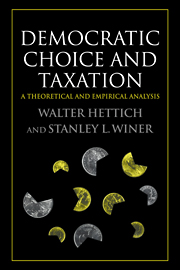Book contents
- Frontmatter
- Contents
- Preface
- 1 Introduction
- PART ONE THEORETICAL FRAMEWORK
- PART TWO COLLECTIVE CHOICE AND THE NORMATIVE ANALYSIS OF TAXATION
- PART THREE APPLIED GENERAL EQUILIBRIUM ANALYSIS
- PART FOUR STATISTICAL ANALYSIS OF TAX STRUCTURE
- PART FIVE POLITICAL INSTITUTIONS AND TAXATION
- 11 Tax Systems in Congressional and Parliamentary Countries
- 12 Conclusion
- Bibliography
- Name Index
- Subject Index
11 - Tax Systems in Congressional and Parliamentary Countries
Published online by Cambridge University Press: 08 October 2009
- Frontmatter
- Contents
- Preface
- 1 Introduction
- PART ONE THEORETICAL FRAMEWORK
- PART TWO COLLECTIVE CHOICE AND THE NORMATIVE ANALYSIS OF TAXATION
- PART THREE APPLIED GENERAL EQUILIBRIUM ANALYSIS
- PART FOUR STATISTICAL ANALYSIS OF TAX STRUCTURE
- PART FIVE POLITICAL INSTITUTIONS AND TAXATION
- 11 Tax Systems in Congressional and Parliamentary Countries
- 12 Conclusion
- Bibliography
- Name Index
- Subject Index
Summary
Institutions are the rules of the game in a society or, more formally, are the humanly devised constraints that shape human interaction. In consequence they structure incentives in human exchange, whether political, social, or economic.
Douglass North (1990, p. 3)Institutions do not appear explicitly in the voting model that serves as the framework for the preceding chapters. Nonetheless, the institutions of democracy are essential to the meaning of the model. It makes sense to use voting analysis as a basis for the study of fiscal systems in situations where political competition for public office is a well-established tradition. Democratic institutions are therefore an essential aspect of any such investigation, even if they are not formally part of the mathematical formulation.
In this chapter we investigate the role that certain institutional arrangements in democratic states may play in the determination of tax structure. In particular, we consider the nature of intragovernmental or structural competition in the congressional system of the United States and the parliamentary system of Canada, and we investigate the importance of differences in such competition for the determination of tax structure in the two countries.
Structural competition is an aspect of political systems that differs from competitive behavior related to political parties. The essence of such competition is best captured by the expression “checks and balances.” Following Albert Breton (1996), we may say that it exists in any situation where there are competing centers of power within a governing structure.
- Type
- Chapter
- Information
- Democratic Choice and TaxationA Theoretical and Empirical Analysis, pp. 265 - 283Publisher: Cambridge University PressPrint publication year: 1999



